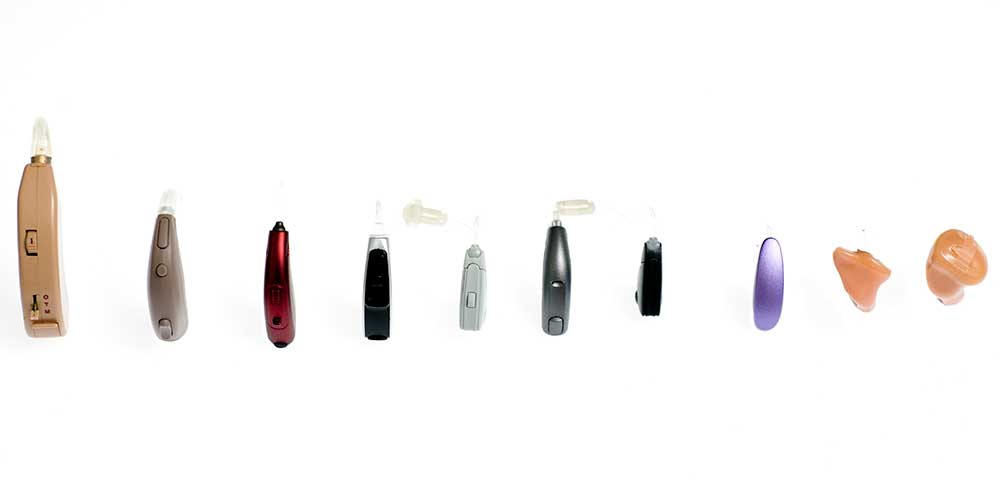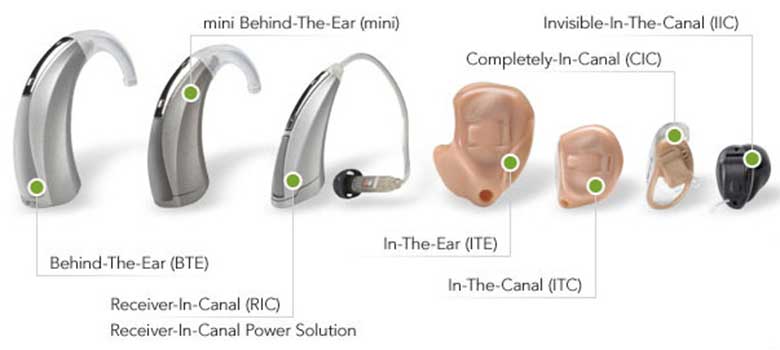Types of Hearing Aids and How to Choose the Right One
Updated:
Retirement Living takes an unbiased approach to our reviews. We may earn money when you click a partner link. Learn More

When shopping for hearing aids, the options available can feel overwhelming. You’ll find an array of types and sizes, each one touting a list of unique features and prices.
So, how do you know what hearing aid is best? We recommend taking a hearing test to understand your degree of hearing loss first. Then, explore the various over-the-counter hearing aids and prescription devices offered by hearing aid companies.
Shopper’s tip: No hearing aid can restore lost hearing and no hearing aid eliminates all background noise. If you see companies making these claims, it’s best to look at another brand, read reviews, and consult a licensed audiologist for recommendations.
Hearing Aid Types, Explained
The trend in recent years has been towards smaller, less noticeable hearing aids. Many smaller devices pack a lot of amplification technology and features into a little space, but it’s important to choose a hearing aid that fits your lifestyle.
Here’s a look at the types of hearing aids on the market and the advantages of each.
| Hearing Aid Style | Fit and Use |
| Behind-The-Ear (BTE) | Speaker behind the ear Largest style Mild to severe hearing loss |
| Receiver-In-Canal (RIC) | Speaker in the canal Similar to BTEs, with better amplification Mild to moderate hearing loss |
| In-The-Ear (ITE) | Speaker in the outer ear Biggest, custom-fit option Mild to severe hearing loss |
| In-The-Canal (ITC) | Components in the lower, outer ear and in canal Custom-fit, smaller ITE model Mild to moderate hearing loss |
| Completely-In-Canal (CIC) | Speaker in the canal Small, custom fit Mild to moderate hearing loss |
| Invisible (IIC) | Speaker in the canal Smallest and most discreet model Mild to moderate hearing loss |
Completely-In-Canal (CIC) Hearing Aid
Best for mild to moderate hearing loss
Known as a CIC model, a completely-in-canal hearing aid is designed to fit entirely in the ear canal. In most cases, they’re molded to specifically fit the wearer’s ear.
- Pros: With a discreet appearance, it is the smallest and least visible type of hearing aid on the market. The device is simple without features that may raise the price. And because the hearing aid fits comfortably in your ear canal, it delivers a more natural sound with less wind and funnel sounds.
- Cons: Its small size comes at the cost of tiny batteries. These batteries often have a shorter lifespan, and may be difficult to remove and replace. Additionally, these types of hearing aids can sometimes become clogged with earwax, making them sound muddied until cleaned. The lack of extra features also means there usually is no volume control.

Invisible (IIC) Hearing Aids
Best for mild to moderate hearing loss
Similar to a CIC model, the invisible-in-canal hearing aid is a tiny device that sits deep in the ear canal, after the second bend. It is slightly larger than a CIC aid, though both are smaller and less noticeable than BTE or RIC models.
- Pros: This is the most discreet style of hearing aid and is designed to be completely invisible to others. If you lead an active lifestyle, they can be a great choice as they fit firmly and are less likely to become dislodged during movement.
- Cons: As with other discreet types, they can be hard to manipulate because of their size. Most come with a removal line to help retrieve them from the ear, but this can be hard to manipulate if you have less dexterity in your hands.
In-The-Canal (ITC) Hearing Aids
Best for mild to moderate hearing loss
In-the-canal hearing aids, sometimes listed as ITCs, are custom molded like a CIC model, but they only fit partially in the ear canal.
- Pros: One of the less visible and smaller styles. However, since it’s a larger device than the CIC-type, and not entirely placed in the ear canal, you may gain room to include some features not found on smaller models, like the ability to pair with smartphones. Another advantage of the in-the-canal as opposed to the completely-in-canal models is that they can be more comfortable for people who have small ear canals.
- Cons: Like the CIC, it’s susceptible to clogging and can be tricky to operate or replace batteries.
In-The-Ear (ITE) Hearing Aid
Best for mild to severe hearing loss
An in-the-ear hearing aid, also known as ITE, is usually found in two styles. One is built to fit in the ear’s entire bottom half while the other fits only partly in the bottom half of the ear. There’s not much of a performance difference between the half-shell and full-shell, just a matter of comfort.
- Pros: Since this is a full-sized hearing aid compared to the smaller “in-canal” models, you’re more likely to find extra features like volume control and a greater amplification for more severe hearing loss. A hearing aid of this size is also easier to operate for hands that have lost some dexterity and have a longer battery life.
- Cons: Increased wind noise is likely and the device is more visible to others.
Behind-The-Ear (BTE) Hearing Aid
Best for mild to profound hearing loss
The behind-the-ear, or BTE hearing aid, is the more traditional style that’s been around for many years. This style fits your ear in two parts – one that slides over the top of your ear and hangs behind it and an earpiece in the ear canal with a small tube connecting the two parts.
- Pros: Its larger size means it’s capable of more amplification than any other model. The large size also means it’s less likely to get lost and will hold the longest battery life.
- Cons: Some newer models are more streamlined and smaller, but this is usually the biggest and most visible type of hearing aid.
Receiver-In-Canal (RIC) Hearing Aid
Best for mild to extreme hearing loss
The receiver-in-canal (RIC) hearing aid is fairly similar to the behind-the-ear hearing aid, but a small wire connects the two parts instead of a tube.
- Pros: You’ll get the same benefit of greater amplification and longer battery life as the Behind-the-Ear model. However, the behind-the-ear portion is significantly less visible.
- Cons: This model is still fairly visible as a larger model and they’re often more expensive than BTE devices.
Hearing Aids vs. Hearing Amplifiers
While hearing aids and hearing amplifiers serve some of the same needs, they are completely different types of devices.
A hearing amplifier does not require a prescription and instead amplifies all sounds. This means that they don’t differentiate between different sound levels or tones, and may amplify even very loud noises. They can be good choices for someone looking to hear far away sounds better,—a hunter may wear an amplifier while hunting, for example. They can also be beneficial for those with very mild hearing loss.
Hearing aids, on the other hand, are designed to work alongside a user’s specific needs. They identify sounds you have difficulty hearing and amplify them to be both louder and clearer. Hearing aids typically require an audiological evaluation and a resulting prescription unique to you, similar to how it works for eyeglass prescriptions. As of 2022, some hearing aids are also available over-the-counter.
Disposable vs. Rechargeable Hearing Aids
Hearing aids are available, depending on the model, with both disposable or rechargeable batteries.
Disposable batteries are familiar and convenient, as you can keep extra batteries in your hearing aid case and ensure that you are always able to swap batteries when needed. Additionally, all hearing aid types are available with disposable batteries, while rechargeables are not available in Completely-in-Canal or Invisible-in-Canal devices.
Rechargeable batteries offer convenience as you don’t need to manipulate small devices to remove their small batteries. They are also environmentally friendly, as you will not need to replace multiple batteries a year.
Read more: Hearing Aid Technology
How to Choose the Right Type of Hearing Aid
Now that you know what types are available, how do you decide which one you need? There are a few key steps to the process.
- Visit your doctor: To start, you should visit your doctor if you haven’t already. Hearing loss is occasionally caused by non-permanent factors such as earwax or other debris.
- Schedule a hearing test: Depending on your doctor’s findings, they will likely have you schedule a hearing test to check how much hearing loss you have and what specific types of sounds you may have problems hearing.
- Visit an audiologist: Once a doctor confirms your hearing loss, you should schedule a more in-depth hearing appointment with an audiologist. They will analyze your ears and determine how severe your hearing loss is and what type of hearing aid you need.
- Understand your prescription: When researching hearing aid types, consider what is best for your specific hearing loss. For example, those with more severe hearing loss will likely be more restricted in what types of hearing aid to choose from than those with mild or moderate hearing loss.
- Consider your lifestyle: While the type of hearing loss you have is the biggest factor in choosing a hearing aid, there are other important factors. If you lead an active lifestyle, you may need a device that fits more snugly so as not to become dislodged while running. If you have to work with people often or be on camera, you may be more comfortable with a more discreet device style. Most hearing aids have a free or low-cost/no-obligation trial period to determine if the device is right for you, so test the exact model you’re interested in.
The Bottom Line on Hearing Aids
Hearing aids drastically improve hearing in many patients and can also improve speech. With advancements in affordability, discreetness, and effectiveness, hearing aids can also fit anyone’s lifestyle. We go more in-depth on hearing aid technology here so you can discover what features are must-haves as you take the next step.